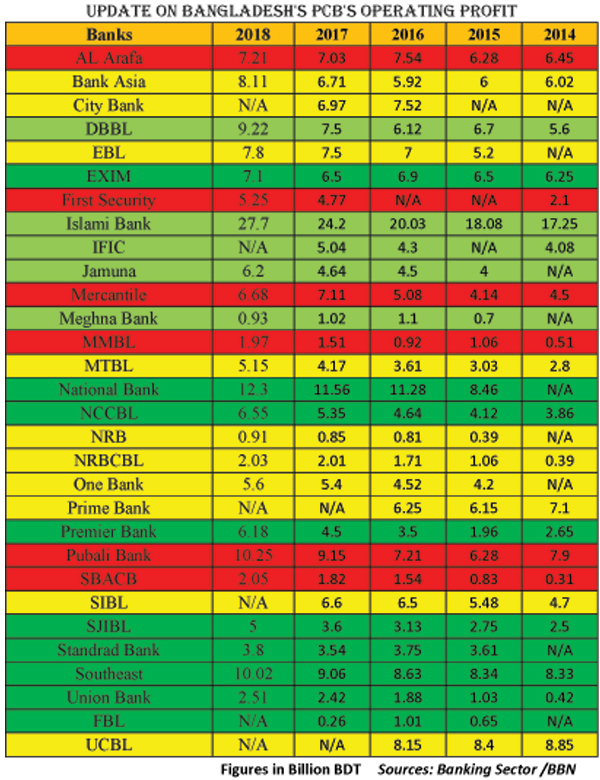 Dhaka, Bangladesh (BBN)- The un-audited operating profits of the country's private commercial banks (PCBs) witnessed a remarkable growth in 2018, even if classified loans are on the rise, bankers said.
Dhaka, Bangladesh (BBN)- The un-audited operating profits of the country's private commercial banks (PCBs) witnessed a remarkable growth in 2018, even if classified loans are on the rise, bankers said.
Most of the banks, expecting a few, maintained their operating profits growth despite declining trend of interest rate spread, according to the bankers.
The weighted average spread between lending and deposit rates offered by the commercial banks came down to 4.22 per cent in October from 4.41 per cent in January 2018, according to the Bangladesh Bank (BB) statistics.
Besides, they explained, the sluggish trend in the country’s capital market alongside the private-sector credit growth led to the lower level of profits of the banks in the outgoing year.
The capital market ended 2018, a gloomy year for it, as the core index of the Dhaka Stock Exchange (DSE) suffered a 14 per cent loss amid lack of investors' confidence.
Between January 01 and December 27, DSEX, the prime index of DSE, dropped 859 points or 14 per cent to close the year at 5,385 on Thursday, the last trading day of 2018.
The private sector credit growth stood at 14.72 per cent in October 2018 on a year-on-year basis compared to 14.67 per cent a month ago. It was 14.95 per cent in August 2018.
The growth was more than 2.0 percentage points lower than the BB’s target of 16.8 per cent for the first-half of the current fiscal year (FY) 2018-19.
They also said higher volume of non-performing loans (NPLs) has also pushed down the operating profit of the banks in 2018.
The amount of classified loans rose by nearly 34 per cent or BDT 250.67 billion to BDT 993.70 billion as on September 30, from BDT 743.03 billion as on December 31, 2017, according to the central bank’s latest statistics.

On the other hand, some banks have been able to increase their operating profits following higher earnings from their treasury operations, according to banking sector insiders.
They said the banks having OBU (Offshore Banking Units) operations with notable amounts earned significantly through providing foreign currency loans to their customers.
A good number of banks earned higher profits from their 'interest income' as the banks had charged higher on lending while provided lower interest rates on deposits in line with the decision of the Bangladesh Association of Banks (BAB), the lobbyist group.
Earlier on June 20, the BAB decided to cut back on the interest rates on both lending and deposits at 9.0 per cent and 6.0 per cent respectively from July 01.
"Some banks have already been able to reduce the volume of their NPLs through strengthening their recovery drives along with rescheduling of their troubled credits ahead of the polls," a senior executive of a leading PCB explained.
He also claimed that the volume of NPLs in the banking sector will fall in the final quarter of 2018.
Operating profit, however, does not indicate the real financial health of a bank since the lenders have to make room for provisioning against bad loans and taxes that have to be paid to the government from the profits.
Operating profits of the banks and non-banking financial institutions are a major source of income tax of the National Board of Revenue (NBR).
As such, the aggregate operating profits of the PCBs have an impact on the revenue collection in the form of direct taxes collected by the revenue board.
The Bangladesh Business News (BBN) has so far managed to collect operating profits of 25 private commercial banks (PCBs), out of a total of 40.
BBN/SSR/AD